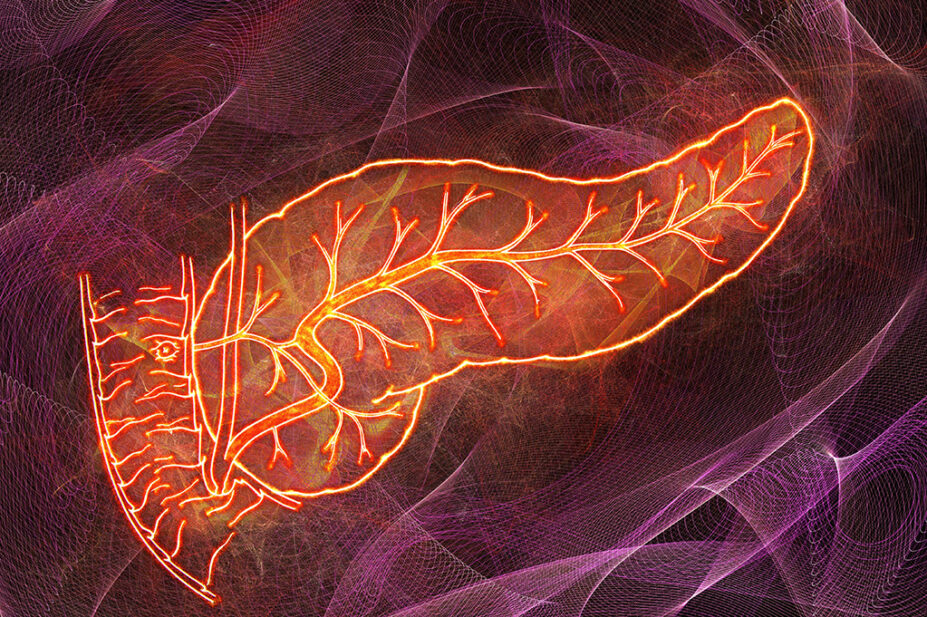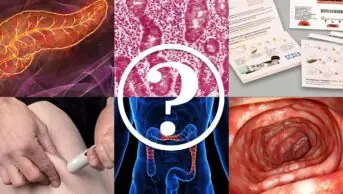
MEHAU KULYK/SCIENCE PHOTO LIBRARY
Learning objectives
After reading this article, you should be able to:
- Recognise the signs, symptoms and methods of diagnosing acute and chronic pancreatitis;
- Know how to manage a patient with acute or chronic pancreatitis and the complications associated with the disease;
- Be able to help and support your patients in avoiding or managing pancreatitis.
Introduction
Pancreatitis is the inflammation of the pancreas, which may be acute or chronic[1]. The difference between acute and chronic pancreatitis is the speed of onset and duration: acute pancreatitis occurs suddenly and has a short duration, whereas chronic pancreatitis develops gradually, worsens over time and can lead to permanent organ damage[2].
The pancreas is located behind the stomach and is essential for digesting the foods we eat. It does this in two important ways: first, it is responsible for producing and secreting digestive enzymes, such as amylase and lipase, to enable the digestion of protein, starch and fats in our diets. These enzymes are secreted into the duodenum, where they mix with food and bile. Second, the pancreas produces hormones, including insulin, which balance blood sugars and overall energy stores in the body.
Digestive enzymes and proteases are synthesised and stored in the inactive state, known as zymogens. Zymogens are usually transported and activated within the duodenum; however, when the pancreas becomes inflamed in acute pancreatitis, zymogens are released and activated prematurely from the pancreatic acinar cells and lead to enzyme-mediated autodigestion, whereby the pancreatic enzymes destroy its own tissue[3]. This in turn leads to inflammation and an inflammatory response, which is designed to heal the affected area; however, over time the healing process replaces necrotic issue with fibrotic tissue leading to the development of chronic pancreatitis[4]. Some patients with chronic pancreatitis will eventually develop a type of diabetes known as pancreatogenic (or type 3c) diabetes[5].
The UK incidence of acute pancreatitis is approximately 56 cases per 100,000 people per year. In 25% of acute cases, the disease is severe and associated with complications. In these more severe cases, people often require a stay on critical care, their hospital admission is prolonged and the mortality rate is 25%[1].
Chronic pancreatitis is chronic, irreversible inflammation and fibrosis of the pancreas. Patients often present with severe pain and symptoms related to endocrine and exocrine insufficiency[5]. The incidence of chronic pancreatitis in western Europe is around 5 new cases per 100,000 people per year; however, this rate is believed to be an underestimation[1]. Men are more likely to suffer from chronic pancreatitis and the average age of onset is between 36 and 55 years[1].
Pharmacists in both primary and secondary care can help prevent patients’ symptoms from recurring or deteriorating. Pharmacists can promote a healthy lifestyle including dietary advice to reduce the consumption of high-fat foods, educate patients on the significance of avoiding alcohol and provide smoking cessation advice and signposting. Pharmacists can also highlight medicines that may be causing or precipitating symptoms of pancreatitis and can suggest or prescribe alternative treatments that may be more appropriate.
Causes
The two most common causes of acute pancreatitis are gallstones (particularly 5mm or smaller) and alcohol consumption[6,7]. Although 70–80% of cases of acute pancreatitis owe to alcohol misuse and gallstones, the exact mechanisms by which they initiate acute pancreatitis are unknown[8]. Gallstones are formed in the gallbladder owing to an imbalance in the chemical make-up of bile inside the gallbladder. They can trigger acute pancreatitis as they move out of the gallbladder and block the pancreatic ducts, which in turn causes inflammation[9].
Alcohol is believed to cause precipitation and increase the viscosity of pancreatic secretions which can lead to the development of protein plugs in the small ducts which form calculi. These calculi cause progressive inflammation and fibrosis, which leads to a loss of acinar, islet and ductal cells. Alcohol can also lead to the premature activation of trypsinogen and other digestive enzymes which can lead to autodigestion[10].
Do not assume that, just because a patient drinks alcohol, it is the cause of their acute pancreatitis.
Causes can be remembered by using the acronym ‘GET SMASHED’:
- Gallstones;
- Ethanol;
- Trauma;
- Steroids;
- Mumps;
- Autoimmune disease (e.g. systemic lupus erythematosus);
- Scorpion venom;
- Hypercalcaemia and hyperlipidaemia;
- ERCP;
- Drugs (e.g. azathioprine, sulfasalazine, carbimazole, sodium valproate, tetracyclines, diuretics and antidiabetic medicines, including exenatide and sitagliptin).
Pharmacists can help identify pancreatitis by conducting a full medication and social history. They can then conduct a medication review to check for drug-related causes of pancreatitis.
Signs and symptoms
The most common symptom of pancreatitis is abdominal pain[1]. Acute pancreatitis pain has a sudden and severe onset of dull pain that is exacerbated by eating and drinking, whereas chronic pancreatitis is usually described as burning or shooting pain that comes and goes over several hours or days[11]. The pain is localised to the right or left upper quadrants, is constant and can often radiate towards the back. The pain is exacerbated by lying flat but can be reduced by leaning forward into the tripod or foetal position.
Pancreatitis can cause inflammation of other gastrointestinal-tract organs. For example compression of the duodenum and stomach outlet can lead to abdominal distention, causing nausea and/or vomiting. Patients also often have a fever, are tachycardic and are often jaundiced[12].
Patients with chronic pancreatitis can also experience symptoms of pancreatic endocrine and exocrine insufficiency. Endocrine insufficiency can lead to non-diabetic hyperglycaemia owing to damage to the islets of Langerhans and is characterised by a deficiency of insulin[13]. Exocrine insufficiency can present as maldigestion and malabsorption owing to damage of the acinar cells, which are responsible for synthesising, storing and secreting digestive enzyme[5,6].
Diagnosis
A diagnosis of pancreatitis will be based on patient history, physical examination, biochemical tests and imaging. A patient history should include alcohol and smoking status as well as medicines and any recent steroid use. Biochemical tests used in diagnosis include plasma amylase and lipase. Reference ranges as follows: amylase 28–100 U/L, lipase 13–600 U/L (refence ranges may vary slightly depending on assay used)[14]. Amylase and lipase results are suggestive of pancreatitis if they are elevated more than three times the upper limit of normal[15]. The degree of amylase elevation does not correlate with the severity of pancreatitis. Amylase is not very specific and increased concentrations can indicate acute appendicitis, gallbladder disease, cancer of the pancreas and ectopic pregnancy[16]. Lipase is more specific than amylase at helping to diagnose pancreatitis. A rapid and sharp rise of lipase in the blood within hours of the attack beginning and a decline after around four days usually indicates acute pancreatitis[17].
The United European Gastroenterology Working Group has suggested that ultrasound, magnetic resonance imaging and computed tomography are the best imaging techniques to confirm a diagnosis of pancreatitis[18].
Prognosis can be established using a scoring system such as Glasgow–Imrie pancreatitis criteria or Ranson’s criteria, which estimate the mortality based on initial and 48-hour blood results[19,20]. The disadvantage to these scoring systems is the 48-hour delay before they can be appropriately applied.
Patients with suspected malnutrition should have blood parameters such as vitamin D, prealbumin, minerals and trace elements (including iron, zinc and magnesium) measured and supplemented if low.
Management
The pharmacological management of acute and chronic pancreatitis differs as a result of their different pathophysiology. Where acute pancreatitis is characterised by sudden, reversible symptoms usually caused by gallstones or alcohol, chronic pancreatitis is related to progressive endocrine and exocrine insufficiency and is more likely to be autoimmune[1,5].
Acute pancreatitis management
Initial treatment of acute pancreatitis focuses on resuscitation with intravenous fluids, analgesia and nutritional support, with early oral feeding favoured if tolerated[21]. Early, aggressive hydration, defined as 250–500mL/h of isotonic crystalloid should be provided to all patients, unless cardiovascular and/or renal co-morbidities exist, within the first 12–24 hours[22]. Compound sodium lactate is usually the preferred replacement fluid and fluid requirements should continue to be re-assessed every 6 hours, with the main goal being to reduce the blood urea nitrogen[22].
Evidence shows that starting enteral feeding as soon as possible improves the gut mucosal barrier function, reducing bacterial translocation and lessening the risk of complications[23]. This can be given parenterally if enteral feeding is contraindicated because of circumstances, such as gut failure, complex pancreatic fistulae and prolonged ileus[23].
Prophylactic antibiotics are not associated with a significant decrease in mortality or morbidity, so routine antibiotics are not recommended for patients with acute pancreatitis; however, there is a role for antibiotics in the treatment of infected pancreatic necrosis; a broad-spectrum antibiotic should be initiated until blood and other cultures are negative and no other source of infection is identified[22,24–28].
Chronic pancreatitis management
By contrast, the management of chronic pancreatitis focuses on addressing the progressive endocrine and exocrine insufficiency[21]. Possible complications include pancreatogenic diabetes, chronic pain and malnutrition[21]. Patients with chronic pancreatitis are at risk of malabsorption, malnutrition and a deterioration in their quality of life, and an assessment with a dietician should be considered[1].
Pancreatic-enzyme replacement has been shown to improve symptoms and digestion in patients with pancreatitis[29]. Initially, one or two capsules of pancreatin should be started during or immediately after a meal and the response reviewed. Dose increases, if needed, should be up-titrated slowly and any side effects, particularly gastrointestinal disorders, monitored closely[30].
Abdominal pain is a predominant symptom of both acute pancreatitis and chronic pancreatitis; however, the pain associated with chronic pancreatitis is often multi-factorial, making a standard regimen of pain control that is effective for every patient impossible[1]. Pain management starts with education surrounding alcohol use, smoking and other lifestyle changes, and pharmacological measures should be considered second. Paracetamol and ibuprofen can often be effective; however, patients may require opioids if this fails to control the pain. Opioid dosing strategies need to be individualised and vary between ‘when required’ dosing to regular high doses of opioids. It is essential that patients are reviewed regularly, weaning plans are developed and analgesic use is monitored, especially given the strong evidence that long-term use of opioids can cause significant harm[1].
Corticosteroids are recommended for people with chronic pancreatitis caused by problems with the immune system, because this can help to reduce inflammation of the pancreas[5]. However, long-term use of corticosteroids are associated with side effects such as osteoporosis, peptic ulceration and diabetes mellitus. Patients should carry ‘steroid treatment cards’, which give clear guidance on the precautions to be taken to minimise risk and provide details of prescriber, drug, dosage and duration of treatment[31].
Complications
One serious complication of acute pancreatitis is pancreatic necrosis and infection. This occurs when the pancreas loses its blood supply, which causes some of the pancreatic tissue to become necrotic. When this happens, the pancreas can also become infected, which can result in sepsis and organ failure[32]. Antibiotics as per local guidelines are always recommended to treat infected acute pancreatitis and should be reviewed regularly with antibiotic choice modified according to culture results[32].
Pancreatic pseudocysts are another complication. They are more commonly associated with chronic pancreatitis, but can also occur in acute pancreatitis. Pancreatic pseudocysts are encapsulated collections of fluid located near the pancreas[33]. Conservative management (the avoidance of intrusive measures, such as surgery) is the gold standard for uncomplicated pseudocysts, but there are also three categories of invasive interventions: endoscopic, percutaneous and surgical drainage or excision[33].
Endocrine insufficiency and diabetes occur in 30–50% of patients with chronic pancreatitis. This is thought to be as a result of a loss of islet cell function owing to ischaemia[34]. Furthermore, owing to irregular calorific intake related to malabsorption and/or alcohol abuse, hypoglycaemia is often common making it difficult to manage endocrine insufficiency and diabetes with insulin[34].
Other complications of chronic pancreatitis include venous thrombosis, bile-duct obstruction and pancreatic cancer[34].
Follow up
After discharge, patients with chronic pancreatitis should be monitored for pancreatic insufficiency and malnutrition. Any vitamin and mineral deficiencies should be treated as appropriate and pancreatic enzyme replacement therapy adjusted[1]. In addition, individuals with chronic pancreatitis should be offered HbA1c testing every six months[1].
Because patients have an increased risk of developing pancreatic cancer after chronic pancreatitis, healthcare professionals should be familiar with the signs and symptoms of pancreatic cancer to ensure that patients are referred immediately upon presentation. Symptoms include jaundice, unintentional weight loss, fatigue and pyrexia[35].
Patient counselling and support
It is essential that patients stop drinking alcohol on diagnosis, even if this was not the primary cause of the pancreatitis. This prevents further damage and may reduce pain. If needed there are treatments for alcohol dependence, which includes counselling, medication and support groups.
Patients should also stop smoking, as it accelerates damage caused by chronic pancreatitis. Smoking cessation services and medicines are available to aid in quitting.
A low-fat, high-protein, high-calorie diet with fat-soluble vitamin supplementation is usually recommended, but patients should not make changes to their diet without consulting a health professional.
Pancreatic enzymes help the digestive system work more effectively, but side effects of these include diarrhoea, constipation, vomiting and abdominal pain. The dosage may need to be adjusted if a patient experiences these.
Opioids may be used for pain management. These should be reviewed regularly to reduce the risk of opioid addiction and to ensure that the patient is not experiencing side effects, such as constipation, nausea and vomiting.
Box: Best practice for pharmacists
Pharmacists should be able to identify patients at risk of developing acute or chronic pancreatitis and advise lifestyle changes as appropriate.
The most important thing that patients can do to improve the symptoms of acute and chronic pancreatitis is to stop drinking alcohol, this prevents further damage to the pancreas and may reduce pain.
Advise patients to stop smoking, patients should be referred to a smoking cessation service.
Be aware of the symptoms of pancreatic cancer: abdominal pain; unexplained weight loss or lack of appetite; jaundice of the skin and/or eyes; change in bowel habits and/or indigestion.
- This article was amended on 20 April 2023 to add antidiabetics to the list of drugs that can cause pancreatitis
- 1Pancreatitis [NG104]. National Institute for Health and Care Excellence. 2018.https://www.nice.org.uk/guidance/ng104/evidence/full-guideline-pdf-6535536157 (accessed Apr 2023).
- 2Banks P, Conwell D, Toskes P. The management of acute and chronic pancreatitis. Gastroenterol Hepatol (N Y) 2010;6:1–16.https://www.ncbi.nlm.nih.gov/pubmed/20567557
- 3Gorelick FS, Thrower E. The Acinar Cell and Early Pancreatitis Responses. Clinical Gastroenterology and Hepatology. 2009;7:S10–4. doi:10.1016/j.cgh.2009.07.036
- 4Bartel M. Chronic Pancreatitis. MSD Manual. 2022.https://www.msdmanuals.com/en-gb/professional/gastrointestinal-disorders/pancreatitis/chronic-pancreatitis (accessed Apr 2023).
- 5Pancreatitis – Chronic. National Institute for Health and Care Excellence. 2021.https://cks.nice.org.uk/topics/pancreatitis-chronic/ (accessed Apr 2023).
- 6Leung PS, Ip SP. Pancreatic acinar cell: Its role in acute pancreatitis. The International Journal of Biochemistry & Cell Biology. 2006;38:1024–30. doi:10.1016/j.biocel.2005.12.001
- 7Chang K, Estores D. Upper Gastrointestinal Conditions: Pancreatitis. FP Essent 2017;458:25–32.https://www.ncbi.nlm.nih.gov/pubmed/28682048
- 8Wang G-J, Gao C-F, Wei D, et al. Acute pancreatitis: Etiology and common pathogenesis. WJG. 2009;15:1427. doi:10.3748/wjg.15.1427
- 9Pancreatitis – Acute. National Institute for Health and Care Excellence. 2022.https://www.nhs.uk/conditions/acute-pancreatitis/causes (accessed Apr 2023).
- 10Klochkov A, Kudaravalli P, Lam Y, et al. Alcoholic pancreatitis. StatPearls Publishing. 2023.https://www.ncbi.nlm.nih.gov/books/NBK537191/ (accessed Apr 2023).
- 11Acute Pancreatitis. NHS Inform Scotland. 2023.https://www.nhsinform.scot/illnesses-and-conditions/stomach-liver-and-gastrointestinal-tract/acute-pancreatitis#symptoms-of-acute-pancreatitis (accessed Apr 2023).
- 12Graham D, Bonica J. Painful diseases of the liver, biliary system and pancreas. In: Bonica’s Management of Pain. Lippincott Williams & Williams 2001. 1293–308.https://worldcat.org/title/42925664 (accessed Apr 2023).
- 13Roy A, Sahoo J, Kamalanathan S, et al. Islet cell dysfunction in patients with chronic pancreatitis. WJD. 2020;11:280–92. doi:10.4239/wjd.v11.i7.280
- 14Amylase: Blood Sciences Test. Exeter Clinical Laboratory International. 2023.https://www.exeterlaboratory.com/test/amylase (accessed Apr 2023).
- 15Crockett SD, Wani S, Gardner TB, et al. American Gastroenterological Association Institute Guideline on Initial Management of Acute Pancreatitis. Gastroenterology. 2018;154:1096–101. doi:10.1053/j.gastro.2018.01.032
- 16Amylase Test. Lab Tests Online UK. 2021.https://labtestsonline.org.uk/tests/amylase-test (accessed Apr 2023).
- 17Lipase Test. Lab Tests Online UK. 2021.https://labtestsonline.org.uk/tests/lipase-test (accessed Apr 2023).
- 18Löhr JM, Dominguez‐Munoz E, Rosendahl J, et al. United European Gastroenterology evidence‐based guidelines for the diagnosis and therapy of chronic pancreatitis (HaPanEU). United European Gastroenterol. j. 2017;5:153–99. doi:10.1177/2050640616684695
- 19Larvin M. Acute Pancreatitis. In: Medicine International. 1994. 291–6.
- 20Berger P, Mollema R, Girbes A, et al. [Acute pancreatitis–a protocol for diagnosis and treatment]. Ned Tijdschr Geneeskd 2001;145:1970–5.https://www.ncbi.nlm.nih.gov/pubmed/11680067
- 21Acute pancreatitis. BMJ Best Practice. 2022.https://bestpractice.bmj.com/topics/en-gb/3000118/pdf/3000118/Acute%20pancreatitis.pdf (accessed Apr 2023).
- 22Tenner S, Baillie J, DeWitt J, et al. American College of Gastroenterology Guideline: Management of Acute Pancreatitis. American Journal of Gastroenterology. 2013;108:1400–15. doi:10.1038/ajg.2013.218
- 23Talukdar R, Swaroop Vege S. Early Management of Severe Acute Pancreatitis. Curr Gastroenterol Rep. 2011;13:123–30. doi:10.1007/s11894-010-0174-4
- 24Isenmann R, Rünzi M, Kron M, et al. Prophylactic antibiotic treatment in patients with predicted severe acute pancreatitis: a placebo-controlled, double-blind trial1 ☆. Gastroenterology. 2004;126:997–1004. doi:10.1053/j.gastro.2003.12.050
- 25Dellinger EP, Tellado JM, Soto NE, et al. Early Antibiotic Treatment for Severe Acute Necrotizing Pancreatitis. Annals of Surgery. 2007;245:674–83. doi:10.1097/01.sla.0000250414.09255.84
- 26Jiang K. Present and future of prophylactic antibiotics for severe acute pancreatitis. WJG. 2012;18:279. doi:10.3748/wjg.v18.i3.279
- 27Villatoro E, Mulla M, Larvin M. Antibiotic therapy for prophylaxis against infection of pancreatic necrosis in acute pancreatitis. Cochrane Database of Systematic Reviews. 2010. doi:10.1002/14651858.cd002941.pub3
- 28Sakorafas G, Lappas C, Mastoraki A, et al. Current Trends in the Management of Infected Necrotizing Pancreatitis. IDDT. 2010;10:9–14. doi:10.2174/187152610790410936
- 29Czakó L, Takács T, Hegyi P, et al. Quality of Life Assessment after Pancreatic Enzyme Replacement Therapy in Chronic Pancreatitis. Canadian Journal of Gastroenterology. 2003;17:597–603. doi:10.1155/2003/515848
- 30Creon 25000 Capsules. Electronic Medicines Compendium. 2021.https://www.medicines.org.uk/emc/product/1168/smpc#gref (accessed Apr 2023).
- 31Prednisolone 1mg Tablets. Electronic Medicines Compendium. 2021.https://www.medicines.org.uk/emc/product/2428/smpc#gref (accessed Apr 2023).
- 32Complications: Acute Pancreatitis. NHS. 2022.https://www.nhs.uk/conditions/acute-pancreatitis/complications/ (accessed Apr 2023).
- 33Misra D, Sood T. Pancreatitis Pseudocyst. StatPearls Publishing. 2022.https://www.ncbi.nlm.nih.gov/books/NBK557594/ (accessed Apr 2023).
- 34Apte MV, Keogh GW, Wilson JS. Chronic Pancreatitis: Complications and Management. Journal of Clinical Gastroenterology. 1999;29:225–40. doi:10.1097/00004836-199910000-00003
- 35Symptoms: Pancreatic Cancer. NHS. 2020.https://www.nhs.uk/conditions/pancreatic-cancer/symptoms (accessed Apr 2023).
2 comments
You must be logged in to post a comment.



In the list of drugs that can cause pancreatitis the anti diabetic medications have been omitted and as use is increasing this is a serious omission
I am the senior editor for research and learning at the PJ. We are currently looking into this with the authors of the article and respond in due course. Many thanks for your comment.